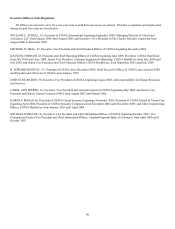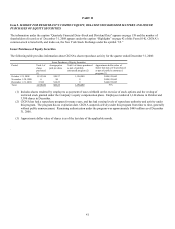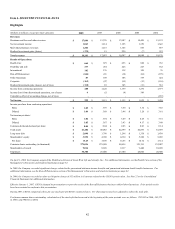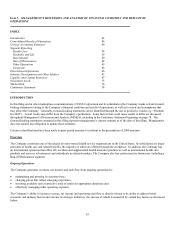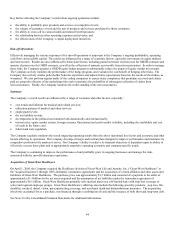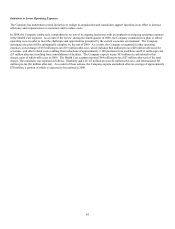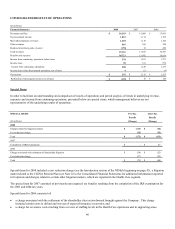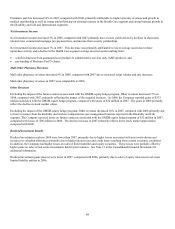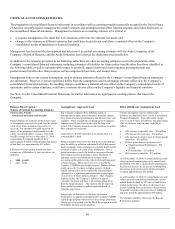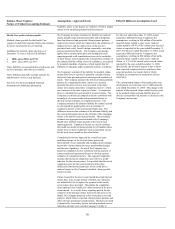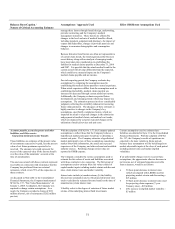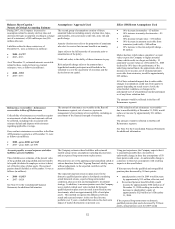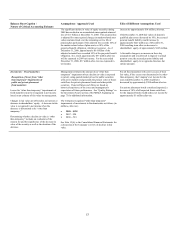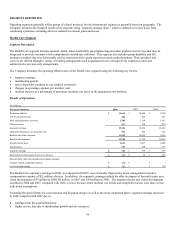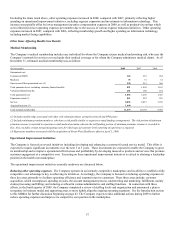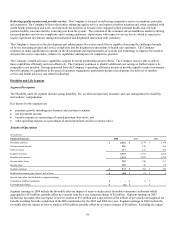Cigna 2008 Annual Report Download - page 69
Download and view the complete annual report
Please find page 69 of the 2008 Cigna annual report below. You can navigate through the pages in the report by either clicking on the pages listed below, or by using the keyword search tool below to find specific information within the annual report.
49
CRITICAL ACCOUNTING ESTIMATES
The preparation of consolidated financial statements in accordance with accounting principles generally accepted in the United States
of America (GAAP) requires management to make estimates and assumptions that affect reported amounts and related disclosures in
the consolidated financial statements. Management considers an accounting estimate to be critical if:
• it requires assumptions to be made that were uncertain at the time the estimate was made; and
• changes in the estimate or different estimates that could have been selected could have a material effect on the Company’s
consolidated results of operations or financial condition.
Management has discussed the development and selection of its critical accounting estimates with the Audit Committee of the
Company’s Board of Directors and the Audit Committee has reviewed the disclosures presented below.
In addition to the estimates presented in the following table, there are other accounting estimates used in the preparation of the
Company’s consolidated financial statements, including estimates of liabilities for future policy benefits other than those identified in
the following table, as well as estimates with respect to goodwill, unpaid claims and claim expenses, postemployment and
postretirement benefits other than pensions, certain compensation accruals, and income taxes.
Management believes the current assumptions used to estimate amounts reflected in the Company’s consolidated financial statements
are appropriate. However, if actual experience differs from the assumptions used in estimating amounts reflected in the Company’s
consolidated financial statements, the resulting changes could have a material adverse effect on the Company’s consolidated results of
operations, and in certain situations, could have a material adverse effect on the Company’s liquidity and financial condition.
See Note 2 to the Consolidated Financial Statements for further information on significant accounting policies that impact the
Company.
Balance Sheet Caption /
Nature of Critical Accounting Estimate
Assumptions / Approach Used Effect if Different Assumptions Used
Future policy benefits –
Guaranteed minimum death benefits
These liabilities are estimates of the present value
of net amounts expected to be paid, less the present
value of net future premiums expected to be
received. The amounts to be paid represent the
excess of the guaranteed death benefit over the
values of contractholders’ accounts. The death
benefit coverage in force at December 31, 2008
(representing the amount payable if all of
approximately 650,000 contractholders had died as
of that date) was approximately $11 billion.
Liabilities for future policy benefits for these
contracts as of December 31 were as follows (in
millions):
• 2008 – $1,609
• 2007 – $848
The Company estimates these liabilities based on
assumptions for lapse, partial surrender, mortality, interest
rates (mean investment performance and discount rate), and
volatility. These assumptions are based on the Company’s
experience and future expectations over the long-term
period. The Company monitors actual experience to update
these estimates as necessary.
Lapse refers to the full surrender of an annuity prior to a
contractholder’s death.
Partial surrender refers to the fact that most contractholders
have the ability to withdraw substantially all of their mutual
fund investments while retaining any available death benefit
coverage in effect at the time of the withdrawal. Once a
partial surrender is made, the liability increases reflecting
lower future assumed premiums, a lower likelihood of
lapsation, and a lower likelihood of account values
recovering sufficiently to reduce the death benefit exposure
in future periods. These effects are not covered by the
Company’s GMDB equity hedge program. Market declines
could expose the Company to higher amounts of death
benefit exposure that can be retained by contractholders
subsequent to a significant partial surrender and to higher
election rates of future partial surrenders. Thus, if equity
markets decline, the Company’s liability for partial
surrenders increases and there is no corresponding offset
from the hedge program. The election rate for expected
future partial surrenders is updated quarterly based on
emerging experience.
Interest rates include both (a) the mean investment
performance assumption considering the Company's GMDB
equity hedge program which reflects the average short-term
interest rate to be earned over the life of the program, and (b)
the liability discount rate assumption.
Current assumptions used to estimate these
liabilities are detailed in Note 7 to the Consolidated
Financial Statements. If an unfavorable change
were to occur to those assumptions, the approximate
after-tax decrease in net income would be as
follows:
• 10% increase in mortality rates - $85 million
• 10% decrease in lapse rates - $30 million
• 10% increase in election rates for future partial
surrenders - $10 million
• 50 basis point decrease in interest rates:
• Mean Investment Performance - $35
million
• Discount Rate - $35 million
• 10% increase in volatility - $15 million
As of December 31, 2008, if contractholder account
values invested in underlying equity mutual funds
declined by 10% due to equity market performance,
the after-tax decrease in net income resulting from
an increase in the provision for partial surrenders
would be approximately $25 million.
As of December 31, 2008, if contractholder account
values invested in underlying bond/money market
mutual funds declined by 10% due to bond/money
market performance, the after-tax decrease in net
income resulting from an increase in the provision
for partial surrenders and an increase in unhedged
exposure would be approximately $50 million.
The amounts would be reflected in the Run-off
Reinsurance segment.



